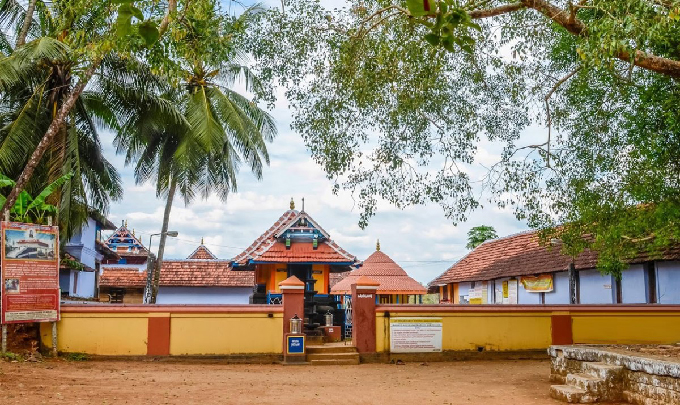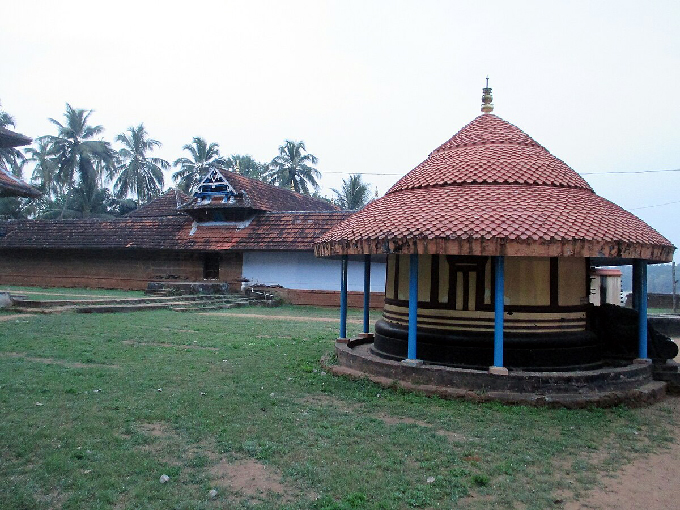108 Divya-deshams: Thiruvithuvakodu
BY: SUN STAFF

Thirumittakode Anchumoorthi Temple, Thiruvithuvakodu
May 01, 2024 — CANADA (SUN) — A tour of the 108 Divya-desams, the divine abodes of Lord Vishnu and Lakshmi.
Thirumittakode Anchumoorthi Temple, or Thiruvithuvakodu (Thiruvithuvakoodu), is a Divya Desham temple that is equally associated with Lord Vishnu and Shiva. The temple is situated on the banks of the Bharathappuzha River at Thirumittacode, in the Palakkad District of Kerala. There are five deities here – one of Shiva and four of Vishnu - known here as Thirumattikodu, anchu (five) Moorthy Temple. The temple is primarily dedicated to the worship of Lord Vishnu as Uyyavandha Perumal with His consort Vithuvakootuvalli (Lakshmi).
Lakshmi and the elephant Gajendra were once worshiping Vishnu here with lotus flowers. When all the lotus flowers were gone, Lakshmi implored Gajendra to pray to Vishnu. Vishnu gave a boon to Lakshmi to reside with him while the whole lotus garden was taken up by Gajendra.

Anchumurti temple
As a Shiva temple, Thiruvithuvakodu is regarded as one of the 108 Shivalayam of Kerala installed by sage Parasurama and dedicated to Shiva. The place is also a Mumurthi Kshetra where the Trimurti – Visnu, Shiva and Brahma – are worshipped. Devotees perform last rites on the banks of the river in the temple, considered to be like Varanasi.
Another legend associated with the place is that Kasi Viswanathan, a Brahmin, came back after visiting the Kasi darshan in this temple.
Constructed in the Kerala style of architecture, there are five separate shrines in the temple complex: one for Shiva, and one each for Vishnu as Abhayapradhan, Vithuvakootuvalli, Vinayaga and Ayyappan.

Here and below, temples installed by Nakula, Sahadeva and Yudihstria
Situated on the banks of the river Bharathappuzha, the temple has no gateway tower but rather has an arch from the main road. A small rectangular wall around the temple, called Kshetra-Madilluka, pierced by the gateways, encloses all the shrines of the temple. The dwajasthambam is located axial to the temple tower leading to the central sanctum.
Chuttuambalam is the outer pavilion within the temple walls. The central shrine and the associated hall is located in a rectangular structure called Nallambalam, which has pillared halls and corridors. Between the entrance of Nallambalam to the sanctum, there is a raised square platform called Namaskara Mandapa, which has a pyramidal roof. Thevrapura, the kitchen used to cook offering to the deity is located on the left of Namaskara Mandapa from the entrance.

The central shrine or Sreekovil houses the presiding deity. The Lord is positioned on an elevated platform with a single door reached by five steps. Only the main and second priests can enter the Sree Kovil.
The central shrine has a circular plan with the base built of granite, superstructure built of laterite and conical roof made of terracotta tile supported from inside by a wooden structure.
During the Mahabharata period the Pandavas built several temples here. Arjuna established the Thiruvithuvakodu temple. When the Pandavas reached the banks of Bharathapuzha River during their exile, they installed the deity of Vishnu.
It is also said that the Ayodya king Ambareeksha got moksha at Thirumittakode. The Maha Vishnu of the temple is called Abhaya Pradhan Temple or Uyyavantha Perumal Temple. Arjuna, one of the brothers, performed penance at this site.
Source: Wikipedia

The Sun
News
Editorials
Features
Sun Blogs
Classifieds
Events
Recipes
PodCasts
About
Submit an Article
Contact Us
Advertise
HareKrsna.com
Copyright 2005, 2024, HareKrsna.com. All rights reserved.

